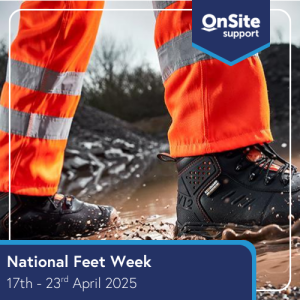National Feet Week

This National Feet Week
We are putting the spotlight
on one of the most overlooked
yet critical aspects of
construction safety
– proper foot protection.
Health & Safety: Stepping Up to New Regulations
According to the HSE slips and trips remain one of the most common workplace risks and injury. New Safety Footwear Standards: After being in place for over a decade, the safety standards for footwear changed in November 2024.
Some of the new safety footwear standards include:
- Changes to slip-resistance and water resistance
- New codes and tests in nail penetration
- New ladder grip tests
Is your team compliant? Read more about the changes here
Wellbeing: The Foundation of Foot Health
Did you know that your feet can be early indicators of serious health conditions? Construction workers with diabetes face unique risks, as the condition can cause nerve damage and reduced circulation in feet. This makes even minor injuries potentially serious.
Diabetes & Foot Protection Connection:
- Early detection of diabetes often starts with symptoms in the feet
- Proper footwear reduces pressure points that can lead to dangerous ulcers for diabetic workers
- Regular foot checks should be part of your wellbeing program
Check out our range of foot protection here to find the right fit for you
Comfort: The Key to Compliance
Safety footwear only protects when it’s actually worn.
Expert Tips for All-Day Comfort:
- Insole Support: Insoles are shoe inserts that change the way your feet work. There are many types of insoles, but generally they work by supporting and cushioning the foot, or by changing the way you walk.
- Lacing Techniques: There are many different lacing techniques, however the right patterns can relieve pressure points and improve fit
- Material Selection: Breathable waterproof membranes keep feet dry without overheating
- Weight Distribution: Innovative sole designs can help reduce fatigue, especially during long shifts
Diversity: One Size Does NOT Fit All
Women in construction deserve more than scaled-down men’s boots. Our safety footwear range acknowledges anatomical differences with purpose-built options.
Male vs. Female Lasts (Foot Forms):
- Women’s feet typically have narrower heels relative to forefoot width
- Different arch heights require specialized support
- Toe box shapes vary significantly between typical male and female foot anatomy
- Women’s ankles are positioned differently, affecting optimal boot height
We offer the a comprehensive range of women’s construction footwear: Click here
This National Feet Week, take a step toward better foot protection. Contact our specialists for a no-obligation footwear assessment for your team :
01293 744 444













